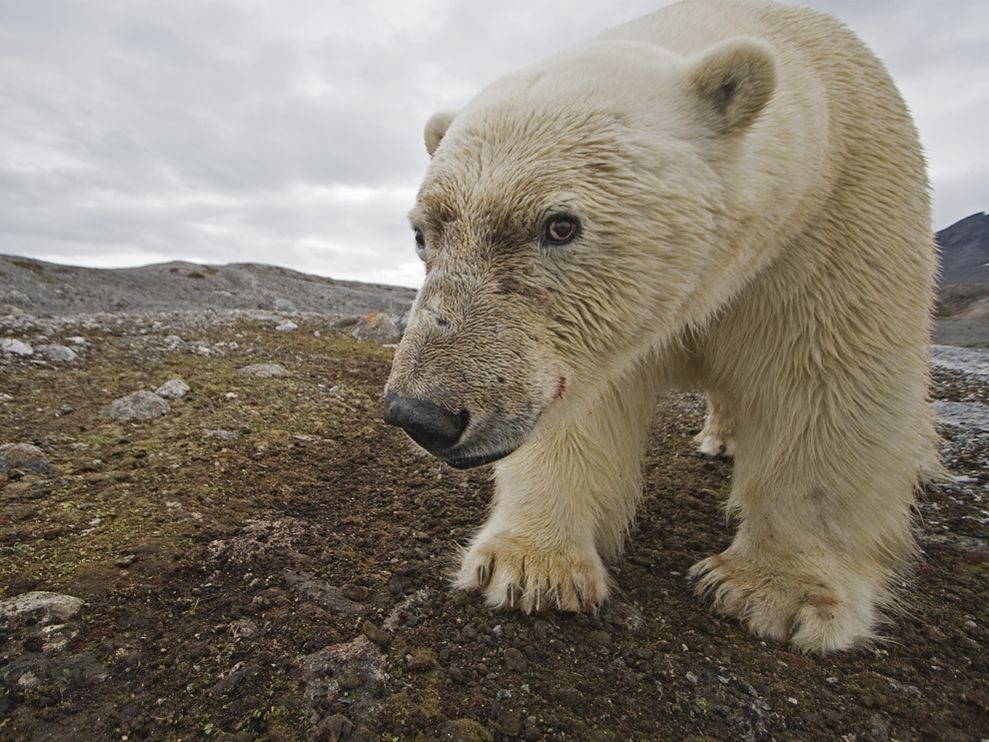Are you a climate change believer or denier?
Trick question.
Like a great many subjects these days, the climate change question has become so politicised from both sides that most people have a very rudimentary understanding of it, regardless of which side they fall on. Worse still, the issue’s apparent complexity discourages most people from getting informed beyond the headlines, even if this subject is of pivotal importance, and even though we as voters hold the power to determine what actions, if any, will be taken. Without an understanding of the details, one becomes susceptible to accepting caricatured descriptions of the scientific debate as truth. My aim here is to provide a primer on climate change science, because of the decisions made, either way will have lasting repercussions for humanity, and perhaps for all life on this planet.
To set the stage properly, we first need to dispel the central myth implied by the question I posed at the beginning: To “believe” or “deny” is not scientific — it’s scientific only to say what’s more likely and less likely. When we’re asking questions about the future, unknowns, and ‘unknown unknowns,’ we’re dealing with inherent uncertainty, so we can speak only in probabilities. Contrast to belief or denial, scepticism is always a defensible position because it has to do with examining and interpreting evidence. With that in mind, we can properly analyse the climate debate, and each draw our own conclusions based on what the available evidence tells us (or doesn’t tell us). It’s best to break the debate down into more specific questions so we can get the fullest possible picture of what we’re facing. Those questions are:
1. Observations: Is Earth’s climate changing? Is global warming real?
2. Attribution: To what degree are humans responsible?
3. Risks: What could the consequences of climate change be for life on Earth?
4. Decisions: What should we do about it? What are the trade-offs?
1. Observations
The first thing to do is to get our terms right. Strictly speaking, Earth doesn’t have a “climate” unless we’re comparing broad eras against each other, or broadly comparing our planet to another planet. We talk about “climate change” because of how the properties of certain regional climates around the world are changing. Next, it’s important to know that Earth’s temperature is always changing and always has been. Over a timescale contextual to Earth’s age — in other words, beyond that of human perception — flux is the rule, not the exception. By measuring proxy indicators like fossilized tree rings and dissolved gasses in ice cores, scientists are able to get an approximation of the conditions that existed long ago. That data is used to chart the temperature from a given region over a long period of time, resulting in the figures below that show that temperature has varied enormously over the last hundred thousand years, let alone the last million.
Temperature
Earth’s temperature is determined by its “energy balance” — the amount of the Sun’s energy that stays in our atmosphere to keep the planet warm, compared to how much of that energy is reflected and lost back into space. The energy balance is in turn determined by net “radiative forcing,” which is a technical term that describes the impact of the different gases and other climate-affecting factors. I’ll elaborate more about the factors that affect radiative forcing under the Risks section. But first, let’s focus on the actual temperature trends.
Last 5 million years

Figure #1 Source: NASA
Last 100 000 years
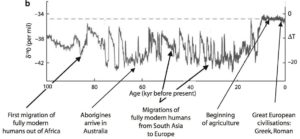
Figure #2 Source: www.cs.toronto.edu
Last 12 000 years
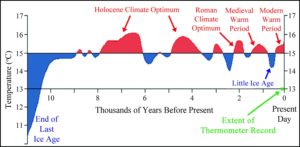
Figure #3 Source: IceAgeNow
Figure 1 demonstrates a clear cooling trend over the last 5 million years, with large variability during the previous million years. Figure 2 zooms in on the latest 100 000 years and, as we can see from Figure 3, around 12 000 years ago a dramatic warming took place. That was when the planet emerged from the last Ice Age, due to predictable shifts in Earth’s axial tilt and orbit around the Sun, known as the Milankovitch cycles. That moment marked the beginning of the Holocene Climatic Optimum that we are still in currently. It’s no accident that the Holocene coincided with the agricultural revolution, which enabled human societies to gain complexity and flourish on the back of farming techniques that weren’t possible in a colder climate. We can also see that the Holocene has featured its own temperature fluctuations, though they are much smaller than those witnessed over a longer timescale. However, it’s important to note that the period two to three hundred years ago, known as the Little Ice Age, was significantly cooler than today.
Industrial era: last ~140 years
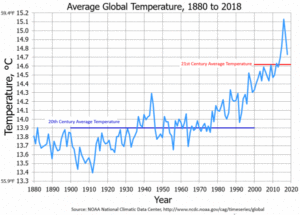
Figure #4 Source: NOAA
Finally, Figure 4 shows that our planet’s global average temperature has indeed warmed about 0.9ºC since we began actively measuring it using thermometers toward the end of the 19th century. That fact is not in dispute, even by the handful of climate scientists who are sceptical of the notion that we’re headed for imminent catastrophe. Those who refer to climate change as a hoax, on the other hand, are flatly wrong: Earth’s climates are changing, and global warming is definitely real because the global average temperature is rising. We often hear that Earth is warmer now than it has been in at least two millennia, and that sounds pretty staggering. Take that statement with a grain of salt, though, and pause to consider that 2000 years is literally a blink of an eye relative to our planet’s history. The graphs tell us that 0.9ºC of warming over 140 years or so isn’t incredibly rare. However, if the century-long warming trend continues at its current pace over the coming decades, it would all but confirm that this time is different.
Carbon Dioxide
Another key observation, seen in Figures 6–8, is that Earth’s atmosphere now contains over 400 parts per million (ppm) of carbon dioxide (CO2), a level not seen for the last 3.6 million years. Again, we need to look at this in context: Figure 5 shows that our atmosphere’s CO2 content has varied greatly over Earth’s history, and has been much, much higher in the (distant) past.
Last 500 million years
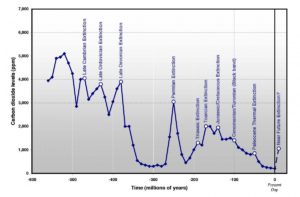
Figure #5 Source: JohnEnglander
Last 400 000 years
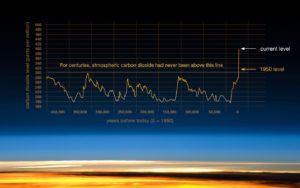
Figure #6 Source: NASA (Credit: Vostok ice core data/J.R. Petit et al.; NOAA Mauna Loa CO2 record.)
Last ~160 years
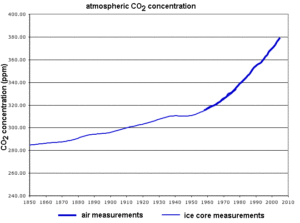
Figure # 7 Source: Johnstonsarchive
Last ~55 years

Figure #8 Source: NASA
Contrary to what you’ve probably heard, carbon dioxide isn’t a pollutant — a higher CO2 concentration encourages plant growth, leading to lush forests. In turn, the presence of all that extra oxygen-emitting vegetation raises the air’s oxygen content. Our atmosphere is currently 21% oxygen, but 300 million years ago it was 35%, which enabled insects to become….larger.
Planet Earth’s atmosphere has indeed experienced much higher CO2 levels before, but those increases usually occurred gradually enough that plant life had time to adapt and accommodate it into the carbon cycle. On the occasions when CO2 spikes too quickly, an extinction event follows soon after.
In other words, carbon dioxide by itself isn’t necessarily bad. The problem, as we can see from Figures 7 and 8, is that by burning fossil fuels we have greatly increased the atmosphere’s CO2 content virtually overnight, as far as the planet is concerned. Planet Earth’s atmosphere has indeed experienced much higher CO2 levels before, but those increases usually occurred gradually enough that plant life had time to adapt and accommodate it into the carbon cycle. Figure 5 shows that on the occasions when CO2 spiked too quickly, an extinction event followed soon after.
Since the first industrial revolution began a century-and-a-half ago, the combustion of fossil fuels has artificially added more than 100 parts per million (ppm) of CO2 to the atmosphere — almost 1 ppm per year. Our current pace is more like 2–3 ppm per year, and other things being equal, that rate is only going to increase further as humanity’s economic activity grows. It’s impossible to know for sure, but it’s doubtful that the carbon cycle will be able to accommodate this new CO2 fast enough to prevent it from having knock-on effects that will increase Earth’s energy balance (that is, warm the planet). It’s estimated that, at minimum, we’re locked into another 0.6ºC of global warming thanks to the CO2 that’s already been emitted.
2. Attribution
As was mentioned earlier, there’s little to no dispute over whether Earth’s average temperature has been rising over the last century. The question that sceptics raise, however, is how much human activity has contributed to that rise. The technical name for human culpability is Anthropogenic Global Warming (AGW). In fact, some believe that human impact on the planet is having such profound consequences that in the last two centuries we’ve moved beyond the Holocene era, and entered into a new geologic epoch known as the Anthropocene.
Average temperature vs CO2 concentration
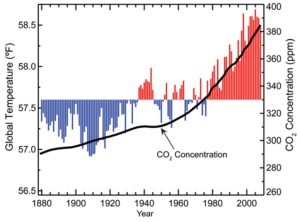
Figure #9 Source: nca2009.globalchange.gov
By superimposing the graphs (Figure 9) showing the atmospheric CO2 concentration since the industrial revolution with the temperature rise over the same period, and noting that the curves look suspiciously similar, it seems obvious that human activity plays a major role in warming the planet. Not only do we artificially release CO2 by burning fossil fuels, but we also cut down forests that would otherwise remove CO2 from the air (known as “carbon sinks”), and we breed livestock that emit large amounts of methane — a greenhouse gas whose lifetime in the atmosphere is short, but that traps 30 times more heat than CO2.
While the Intergovernmental Panel on Climate Change (IPCC) attributes most of the warming to human impact, sceptics like Richard Lindzen, a professor emeritus of meteorology at MIT, are much more reluctant to conclude the same. He argues that, according to his interpretation of the evidence, AGW accounts for perhaps half of the observed warming at most (the other half being caused by natural factors). For those so inclined, you can watch Lindzen explain his views in depth here.
Sceptics have two main criticisms of the AGW hypothesis. First, they point out that there has been very little detected rise in the average global temperature since 1998, even though CO2 concentration and emissions have been steadily increasing the whole time. If human emissions are responsible for warming, why hasn’t the warming trend also continued in a predictable fashion? (Update: warming has resumed — see Figure 4.)
An apparent reply to this point is that Earth’s thermal inertia delays the full amount of warming and that in any case much of the “missing” warming can, in fact, be accounted for in the oceans and the arctic. Also, it’s the much longer trends spanning a century or more that we should pay the most attention to because short term variability is inevitable. Still, only more time and study will allow us to answer these sorts of questions with greater confidence.
Sceptics’ second criticism has to do with the IPCC’s computer models, which are responsible for having produced the predictions of warming ranging from 1.5ºC to 6ºC above the pre-industrial average by the 21st century’s end given various possible emission scenarios. As Figure 10 below demonstrates, the models used to predict global warming have diverged considerably from the observed temperature so far. Sceptics ask how we can put so much faith in the models’ future predictions, given that their predictions so far have been seemingly disproven by reality. (Update: Figure 11.)
Climate Modelling
The economist William Nordhaus explains that the modelling process involves:
[a]n experiment in which (case 1) modelers put the changes in CO2 concentrations and other climate influences in a climate model and estimate the resulting temperature path, and then (case 2) modelers calculate what would happen in the counterfactual situation where the only changes were due to natural sources, for example, the sun and volcanoes, with no human-induced changes. … This experiment showed that the projections of climate models are consistent with recorded temperature trends over recent decades only if human impacts are included. [citation i]
But climate modelling isn’t perfect, and it relies on the assumption that if we can understand the factors that caused past climate trends, and use that data in the models, then in theory our models should be able to predict future trends fairly accurately. The IPCC acknowledges that the power offered by models is limited, and wrote in its Third Assessment Report in 2001 that:
[i]n climate research and modelling, we should recognize that . . . the long-term prediction of future climate states is not possible. The most we can expect to achieve is the prediction of the probability distribution of the system’s future possible states by the generation of ensembles of model solutions. [citation ii]
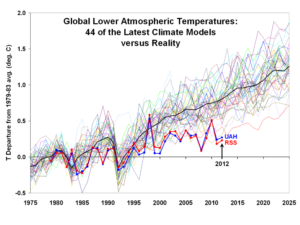
Figure #10 Source: Watts Up With That
 Figure #11 Source: NASA/NOAA/Climate Lab Book
Figure #11 Source: NASA/NOAA/Climate Lab Book
Rather than being able to predict the future precisely, the models offer a range of possible outcomes (click on the source link for Figure 11 to learn more about the difficulties of climate modelling). Figure 10 shows that most of the models overestimated the warming that actually occurred in the 22 years between 1990 and 2012. Figure 11 provides a recent update, showing that warming resumed again after 2012. For the last quarter-century, most projections of warming have given a likely range of 1.5ºC to 4.5ºC above Earth’s pre-industrial average temperature, based on various suppositions of future economic activity, greenhouse gas (GHG) emissions, and climate sensitivity. A study published in the journal Nature on January 2018 narrows that estimate to between 2.2 and 3.4 degrees Celsius of warming, with 66 percent (one standard deviation) confidence. It adds that there’s less than a 3 percent chance that warming will end up below 1.5ºC, and less than 1 percent likelihood of it exceeding 4.5ºC. While that’s good news regarding the worst-case scenario, it also means that the goal set out in the Paris Agreement in 2015, to keep “a global temperature rise this century well below 2 degrees Celsius above pre-industrial levels,” is probably infeasible.
Many of the models have given high warming estimates because they assume that CO2 emissions will trigger “positive feedback loops” that will magnify warming, though it’s tough to say by how much. Sceptics like Lindzen argue that the models fail because they overestimate the effects of those positive feedback loops. In fact, in his opinion, the models don’t account enough for negative feedback loops. I’ll explain more about feedback loops in the next section.
3. Risks
So, we know that Earth is warming, and we know that we’re rapidly adding CO2 to the atmosphere. What we don’t know is the precise effects it will have on the biosphere, let alone on regional ecosystems. Nonetheless, we have some idea of the possibilities.
Cascade of Uncertainty
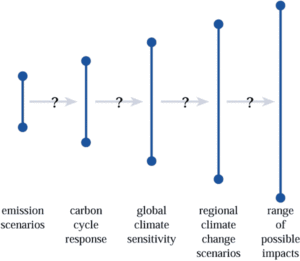 Figure #12
Figure #12
Figure 12 is known as the Cascade of Uncertainty. As the name suggests, it represents the range of possible (and not entirely known) effects that GHG emissions could have on the globe’s temperature, and the further effects that that rise in temperature could have on individual geographic areas. The greatest uncertainty revolves around what’s known as “climate sensitivity”: we simply can’t be sure how easily regional climates or local ecosystems will be altered by shifts in air and ocean temperature, or by the changing balance of gasses in the air and water. Perhaps, as climate sceptics contend, various climates will prove resilient to change maybe human action is in fact relatively impotent, and we can’t control nearly as much as we thought we could. That would mean that we haven’t really got much to worry about, or at least that reducing our GHG emissions is futile, and that we should focus instead on adapting to our impending new situation.
But maybe regional climates are more delicate than we had anticipated, and human action is in the process of setting off chain reactions called “positive feedback loops” and “tipping points” — some that we might not even be aware of — that could cause enormous upheaval in the coming decades. It’s the possibility of this second scenario that demands our prudence.
Feedback Loops
Probably the most well understood positive feedback loop has to do with albedo, which refers to how much light reflects off of a given surface. Dark-coloured surfaces have less albedo and absorb more energy, which is why they are darkly coloured (because less light reflects off of them back to our eye). For the same reason, light-coloured surfaces, like ice and snow, have a high albedo. This has important implications for Earth’s net radiative forcing, because as ice and snowmelt due to warmer temperatures, less of the Sun’s energy is reflected back into space, which warms the planet further, melts even more ice, and further reduces Earth’s albedo.
There are several other confirmed and suspected feedback loops, most of which are “positive” (which is bad). These include changes to the land and ocean carbon cycle, ocean acidification, cloud formation, and an increase in water vapour due to more evaporation. This last phenomenon can be a serious problem because water vapour is the most abundant greenhouse gas of all. On top of strengthening storms and hurricanes, greater evaporation prolongs the time between rainfalls, creating droughts in some regions, and increasing the frequency and severity of forest fires. When the rains finally come, they are torrential, causing floods.
Yet Richard Lindzen remains sceptical about climate “alarmism,” as he calls it. In his opinion, most estimates of future warming don’t account enough for the role played by aerosols, which are very fine particles like dust, smoke from forest fires, and pollutant by-products of human activity. Clouds can’t form without aerosols, because water vapour needs a focal point on which to adhere in order to condense into water droplets. Clouds reflect some of the Sun’s rays back into space, but also reflect back to Earth some of the light that’s reflected off of Earth’s surface. Since the exact effects are still not well understood, there’s debate over whether, on balance, aerosols and clouds add to Earth’s energy, or reduce it as part of a negative feedback loop.
Tipping Points and Irreversibility
There are some suspected positive feedback loops that could represent dangerous “tipping points” because of the sudden and disruptive change they could potentially cause. One of these, mentioned in the link on feedback loops, is the possibility that as arctic permafrost melts, it could release into the atmosphere an enormous amount of dissolved carbon dioxide and methane that’s trapped as bubbles in the ice. Such a large dose of GHGs into the air would theoretically accelerate other feedback loops.
Another major risk is posed by disruption to thermohaline circulation (see video below). This effect, which has to do with the ocean’s heat and salt content, drives ocean currents like the Gulf Stream, which dictates weather and climate for Europe. As the video illustrates, it’s possible that if global warming caused enough of the Greenland ice sheet to melt, it would dilute the northern Atlantic Ocean, reduce its salt concentration, and could potentially slow or even halt the Gulf Stream. In addition, melting icebergs would cool the ocean for the same reason that ice cubes cool down your soda pop. Since the temperature of ocean currents influence regional climates, these effects would cause the European climate would become much colder.
These possible scenarios are both examples of irreversible events. Climatologists also talk about how, as mentioned earlier, even if hypothetically we stopped releasing CO2 into the atmosphere tomorrow, cold-turkey, the GHGs that have already been emitted combined with those that will be released due to feedback loops have locked us into at least another 0.6ºC of further warming. Figure 13 below shows how once released, GHGs linger in the biosphere for hundreds of years, making their presence effectively irreversible on human timescales. If you’re interested in learning more about the science involved, this lecture explains it well.
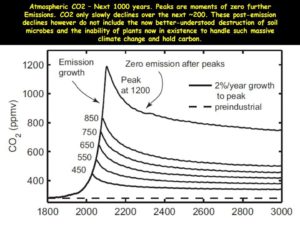 Figure #13
Figure #13
4. Decisions
The most important thing to understand when it comes to the question of “What should we do?” is that the way many people answer that question is determined at least as much by their personal ideological bent as it is by their understanding (or lack thereof) of the relevant science.
It’s no surprise that people who identify as politically conservative are more likely to oppose state action that legislates measures like carbon taxes or cap-and-trade regimes, purportedly because the measures mentioned would reduce fossil fuel production, and could limit job-creation in the private sector. While they surely care about the future of humanity’s place in the natural environment, they place a higher priority on economic benefits in the here and now. People who consider themselves politically progressive, on the other hand, tend to support government action that would discourage or limit GHG emissions, because they view the possible risks posed by AGW as outweighing the immediate economic sacrifices that will have to be made.
But there’s a deeper dimension to this debate as well. Progressives tend to approve of government intervention in the economy because they see such action as necessary for preserving a just society, and the possible negative externalities posed by climate change qualify as an injustice that needs to be avoided. Conservatives would generally prefer that government play a smaller role in their lives, so tend to oppose higher taxation and what they see as government interference in the economy. Ideological rifts shouldn’t be overlooked because many people have political biases one way or another that can cloud their judgment and can prevent us from pursuing the best policies based on what the balance of scientific evidence indicates.
The Precautionary Principle
The Precautionary Principle has long been invoked regarding climate change, and operates on the logic of “better safe than sorry,” especially when the stakes are high.
First, a word of caution is necessary, because the Principle has limitations. If it’s misapplied, we could end up forsaking potential benefits offered by economic expansion just to avoid frightening climate scenarios that might have a very small chance of coming true. Some climate sceptics argue that abandoning the use of fossil fuels immediately would prevent people in places like China and India from reaching the same standard of living that we in the West enjoy, and that would be profoundly unfair. In his TED Talk, the Danish political scientist Bjorn Lomborg argues that in a world of scarcity, we should devote our money and attention to solving more pressing problems first, like hunger, poverty, and disease. Arguments like these shouldn’t be dismissed.
“A sensible policy would pay a premium to avoid the roulette wheel in a Climate Casino.”
So how do we decide what to do? William Nordhaus compares the climate change predicament to a roulette wheel in a casino. Each time we spin the wheel, we resolve one of the uncertainties we face — let’s use the steps shown in the Cascade of Uncertainty as a guide.
Our first spin determines our accumulated level of GHG emissions a decade from now; a second spin, two decades, etc. Subsequent spins reveal the effects those emissions have on the carbon cycle, global climate sensitivity, and regional ecosystems. If the roulette ball lands on black, the outcomes across these dimensions are better than expected: we all breath a collective sigh of relief, the sceptics tell us that they told us so, and the world continues on with business as usual. If the ball lands on red, the results match or slightly exceed the IPCC’s worrying predictions, and the world scrambles to mitigate or adapt to shifting climates and damaged ecosystems.
But if the ball lands on zero or double-zero, our worst fears are confirmed, and humanity is faced with a scenario that it’s simply not prepared for. Tipping points are reached, ecosystems are destroyed, several animal species go extinct, sea levels rise dramatically as the ice sheets in Greenland and West Antarctica melt, and flooding makes low-lying coastal areas like Venice and the Maldives uninhabitable. Furthermore, Nordhaus points out that costly outcomes are more likely: we remain uncertain about how climate works in several ways, and those uncertainties could interact with one another to magnify the changes that might otherwise have been smaller on their own. We also need to try and account for the possibility of “unknown unknowns,” — the questions that we haven’t yet thought to ask. Those are the factors that we don’t know that we don’t know.
Nordhaus says that climate sceptics are in effect suggesting that “the ball will always land in the black pocket,” whereas “a sensible policy would pay a premium to avoid the roulette wheel in a Climate Casino.”iii Most climate sceptics would probably agree that we’re playing on a roulette wheel, but they would say that there are more black pockets than red ones, and that “climate alarmism” is more of a political construct than a scientific fact. Still, Richard Lindzen himself has acknowledged that if he turns out to be wrong, and humans really are the main cause of climate change, we can take action in fifty years.
As a single scientist giving an opinion, that’s fine. But as a society, we need to make decisions now based both on what the balance of evidence is telling us, and on our level of uncertainty compared to the risks we face. That inherent uncertainty means that there are some things science can’t help us with, and those decisions will be informed by how we answer questions of what we value. What level of risk is acceptable? What potential benefits are we willing to forsake? Are we capable of overcoming the worst-case scenario, should it come to that? None can deal authoritatively on climate policy until they grapple with these fundamental questions.
A fork in the road
That, of course, includes President Trump, whose decision to withdraw the United States from the Paris Agreement was not only out of step with the global consensus, but also badly offside with American public opinion.
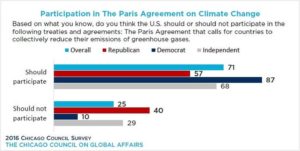 Figure #14 Source: Washington Post
Figure #14 Source: Washington Post
Even if we in the developed Northern Hemisphere benefit from, say, a longer growing season and the economic perks of emitting GHGs with impunity, human beings elsewhere will bear the costs of our comfort. The president of the United States may not be accountable politically to those outside his jurisdiction, but he is so in a moral sense because his decisions on this matter will affect their lives.
The same can be said of President Xi Jinping, because by burning more coal than the rest of the world combined, China is the lead GHG emitter (though America and Canada each emit more than double that of China per capita). The difference is that he aims to bring the remaining 43 million Chinese who live below the country’s official poverty line of 95 cents USD per day above that threshold by 2020. Half a billion — 40 percent of China’s population — live on less than $5.50 per day, and it would be worse if not for China’s rapid, but dirty, economic growth over the last 30 years.
Encouragingly, China recently unveiled plans for a national carbon cap-and-trade market to get emissions under control, and Europe is already light-years ahead in its renewable energy policies. Meanwhile, the Trump administration shilled for coal at the Bonn climate conference.
Overall, these leaders have a long way to go if the world is going to meet its climate goals. And consider this: a 2015 study from researchers at University College London estimated that:
to have at least a 50 percent chance of keeping global warming below 2°C throughout the 21st century…a third of oil reserves, half of gas reserves and over 80 per cent of current coal reserves should remain unused from 2010 to 2050.
That was what we thought in 2015. Now we know that keeping warming below 2.2°C is probably impossible. We can subtract at least five years’ worth of fossil fuel usage from the quota they had in mind starting in 2010, and we’re still expanding production. Let that sink in for a moment.
As a candidate for a Great Filter event in the human saga, climate change could be our existential test. I’m still trying to remain optimistic.

